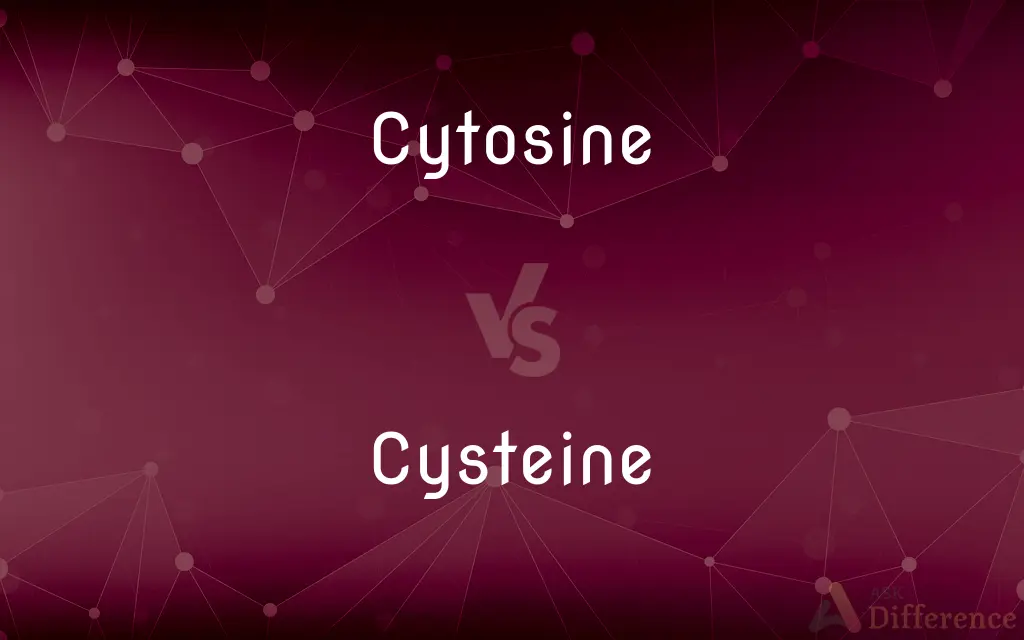Cytosine vs. Cysteine — What's the Difference?
Edited by Tayyaba Rehman — By Fiza Rafique — Updated on September 27, 2023
Cytosine is a base in DNA and RNA molecules, while Cysteine is an amino acid used in protein synthesis.

Difference Between Cytosine and Cysteine
Table of Contents
ADVERTISEMENT
Key Differences
Cytosine and Cysteine are both crucial molecules in the realm of biology, but they play distinct roles. Cytosine is one of the four nucleotide bases found in DNA and RNA. It pairs with guanine in DNA to ensure the stability of the double helix structure. On the other hand, Cysteine is a sulfur-containing amino acid. It's integral to the formation of proteins in living organisms.
While Cytosine's role is primarily in the storage and transmission of genetic information, Cysteine contributes to the structure and function of proteins. This amino acid is known for forming disulfide bonds, which help maintain the three-dimensional shape of proteins. These bonds are pivotal in determining the protein's functionality.
Cytosine can be methylated, a process which can impact gene expression in organisms. Conversely, Cysteine is notable for its antioxidative properties, as it's a component of the antioxidant glutathione. This makes Cysteine vital in defending cells against oxidative stress.
In biochemical reactions, both molecules are involved, but their participation is varied. While Cytosine is integral to processes like DNA replication and transcription, Cysteine plays a part in enzymatic reactions and can act as a biological reducing agent.
Comparison Chart
Type
Nucleotide base.
Amino acid.
ADVERTISEMENT
Found In
DNA and RNA.
Proteins.
Role
Genetic information storage and transmission.
Protein structure and function.
Chemical Properties
Pairs with guanine in DNA.
Forms disulfide bonds in proteins.
Biochemical Functions
DNA replication, transcription.
Enzymatic reactions, antioxidative processes.
Compare with Definitions
Cytosine
One of the four main bases in nucleic acids.
DNA contains adenine, thymine, guanine, and Cytosine.
Cysteine
A sulfur-containing amino acid.
Cysteine's presence can influence protein folding.
Cytosine
A pyrimidine derivative.
Both Cytosine and thymine are pyrimidine bases in DNA.
Cysteine
Involved in enzymatic reactions in the body.
Some enzymes require Cysteine for proper function.
Cytosine
A nucleotide base in DNA and RNA.
Cytosine pairs with guanine to form base pairs in DNA.
Cysteine
A biologically important reducing agent.
Cysteine can donate electrons in biochemical reactions.
Cytosine
Involved in the storage of genetic information.
Mutations can occur if Cytosine is mistakenly replaced.
Cysteine
A component in the antioxidant glutathione.
Cysteine helps combat oxidative stress in cells.
Cytosine
Can undergo methylation processes.
Methylation of Cytosine can impact gene expression.
Cysteine
Integral for forming disulfide bonds in proteins.
Disulfide bonds between Cysteine residues stabilize protein structures.
Cytosine
Cytosine (; C) is one of the four main bases found in DNA and RNA, along with adenine, guanine, and thymine (uracil in RNA). It is a pyrimidine derivative, with a heterocyclic aromatic ring and two substituents attached (an amine group at position 4 and a keto group at position 2).
Cysteine
Cysteine (symbol Cys or C; ) is a semiessential proteinogenic amino acid with the formula HOOC-CH-(NH2)-CH2-SH. The thiol side chain in cysteine often participates in enzymatic reactions as a nucleophile. The thiol is susceptible to oxidation to give the disulfide derivative cystine, which serves an important structural role in many proteins.
Cytosine
A pyrimidine base, C4H5N3O, that is the constituent of DNA and RNA involved in base-pairing with guanine.
Cysteine
An amino acid, C3H7O2NS, derived from cystine and found in most proteins.
Cytosine
(biochemistry) A heterocyclic base, 4-aminopyrimidin-2(1H)-one, which pairs with guanine in DNA and RNA (by means of three hydrogen bonds).
Cysteine
(amino acid) A sulphur-containing nonessential amino acid C3H7NO2S found in most animal proteins; it readily oxidizes to cystine.
Cytosine
A pyrimidine (C4H5N3O) which is one of the four major basic components of DNA and RNA in most organisms, forming glyosides with ribose and deoxyribose. It is the basic component of cytidine, deoxycytidine, cytosine, cytidine monophosphate, and derivatives of those compounds.
Cysteine
An amino acid containing sulfur that is found in most proteins; oxidizes on exposure to air to form cystine
Cytosine
A base found in DNA and RNA and derived from pyrimidine; pairs with guanine
Common Curiosities
What is Cytosine?
Cytosine is one of the four nucleotide bases found in DNA and RNA.
What's unique about Cysteine among amino acids?
Cysteine contains a sulfur atom, allowing it to form disulfide bonds in proteins.
How does Cysteine differ from Cytosine?
Cysteine is a sulfur-containing amino acid in proteins, while Cytosine is a base in nucleic acids.
Why is the pairing of Cytosine important in DNA?
Cytosine pairs with guanine, ensuring the stability of the DNA double helix.
Why is Cysteine considered an antioxidant?
Cysteine is a component of the antioxidant glutathione, which protects cells from oxidative damage.
Can Cysteine be synthesized in the body?
Yes, humans can synthesize Cysteine from the amino acid methionine.
Is Cytosine involved in protein synthesis?
No, Cytosine is involved in storing and transmitting genetic information, not protein synthesis.
What happens if Cytosine is methylated?
Methylation of Cytosine can influence gene expression and DNA structure.
Share Your Discovery

Previous Comparison
Shifter vs. Shiftee
Next Comparison
Cash vs. FundAuthor Spotlight
Written by
Fiza RafiqueFiza Rafique is a skilled content writer at AskDifference.com, where she meticulously refines and enhances written pieces. Drawing from her vast editorial expertise, Fiza ensures clarity, accuracy, and precision in every article. Passionate about language, she continually seeks to elevate the quality of content for readers worldwide.
Edited by
Tayyaba RehmanTayyaba Rehman is a distinguished writer, currently serving as a primary contributor to askdifference.com. As a researcher in semantics and etymology, Tayyaba's passion for the complexity of languages and their distinctions has found a perfect home on the platform. Tayyaba delves into the intricacies of language, distinguishing between commonly confused words and phrases, thereby providing clarity for readers worldwide.














































